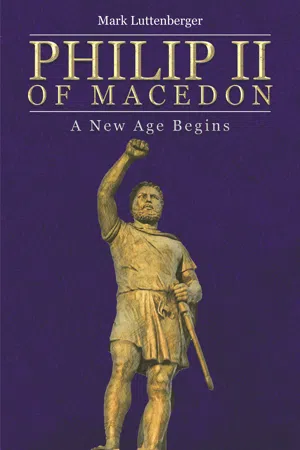![]()
Chapter One
Who Were the Macedonians?
Geography
Before we can tell the story of Philip II and Macedonia, we must answer one question. Who is a Macedonian? Geography, climate, language, religion, political, and social behaviors are the basic criteria to define a Macedonian.
The geography and climate of Macedonia determined the settlement pattern of the early inhabitants. Unfortunately, the borders of ancient Macedonia varied through the centuries. The ancient geographers had difficulty in determining these borders. However, they all agreed that Macedonia and Hellas (Greece) were separate entities. The familiar kingdom of Philip II and Alexander the Great did not appear until the 350s BC.
Map 4—Northern Greece and Macedonia
Map 4—Northern Hellas and Macedonia
(https://commons.wikimedia.org/wiki/Atlas_of_the_Macedonian Empire)
Author: MaryroseB54
The political kingdom known as Macedon was comprised of two regions known as Upper and Lower Macedonia. It was located north of Mt. Olympus, which separated Macedonia from Hellas. Lower Macedonia occupied the fertile plain along the northern coastline of the Thermaic Gulf. In the classical period, its inhabitants primarily lived on the land or in cities identified as poleis by Greek writers. However, unlike the Greek polis (city-state), these cities were not independent. Although self-governing in local affairs, they were subject to the rule of the king at Aegae. He conducted foreign policy and could interfere in local affairs when he deemed it necessary. Whether the kingdom was strong or weak, Lower Macedonia remained subordinate to the king. Although a few inhabitants engaged in trade and industry, the great majority were occupied in agriculture and pastoralism. Lower Macedonia was bordered to the east by the Chalcidic peninsula and the Thermaic Gulf. Its southern border ends at the Pierian Mountains, which separates Macedonia from the Greeks in Perrhaebia and Thessaly.
To the north and west, separated by hills, lies Upper Macedonia. Except for its eastern border on the Strymon River, Upper Macedonia is ringed by mountain ranges that separate it from Greece, Paeonia, Epirus, and Illyria. Only a handful of passes allow access from Upper Macedonia to its neighbors. The Haliacmon corridor, following the Haliacmon River through Orestis, Elimea, and Tymphaea, provides a major entrance route from Upper Macedonia into central Hellas. Most inhabitants were either farmers in the valleys or pastoralists, moving their herds of goats or sheep between the valleys and the mountains contingent on the season and food supply. There were small towns or villages but no large urban centers that could be defined as a city or polis in the Greek definition.
The climate of Upper Macedonia is more continental than the Mediterranean climate of the Greek peninsula. This means that the weather pattern was generally cooler and wetter, especially in the mountain regions. Although summers could be hot, the winters were colder. Rather than wet and dry seasons (May to September) common to the Mediterranean moisture pattern, the average monthly rainfall was more evenly dispersed throughout the year. As a result, this rainfall pattern was more conducive to the yield of agriculture, support of animal herds, and the growth of the hardwood forests (oak, beech, fir, and pine) that prospered in Upper Macedonia.
Upper Macedonia comprised the cantons of Tymphaea, Elimea (Elimiotis), Orestis, Eordaea, Lyncus (Lyncestis), and Derriopus. These cantons had their own independent ruling houses. Their political origins are unknown but may have derived from early tribal organizations. The rulers of Lyncus claimed that they were descended from the Bacchiadae of Corinth in the seventh century (Strabo.7.C326). Lower Macedonia comprised the areas of Bottiaea (Emathia), Eordaea, and Almopia and were inhabited by ethnic Macedones (Thuc.2.99). The fertility of the Macedonian plain derives from the silt deposits of the Haliacmon, Axios (modern Vardar), Loudias, and Echedorus (modern Gallikos) Rivers as they flow into the Thermaic Gulf.
Lower Macedonia was controlled by the Temenid king at Aegae, the initial capital of Macedon. Under strong kings, such as Alexander I (498–454) and Philip II (359–336), some of these Upper Macedonian districts became either subjects or allies of Lower Macedonia. Consequently, Macedonia became a player in the Hellenic political world. Under weak kings, the royal houses of Upper Macedonia ignored the Temenid king and ruled their cantons as independent kings (Thuc.2.99). Not until the fourth century did the cantons of Elimea and Lyncus become fully integrated into the Macedonian kingdom. Unfortunately, when the Macedonian kingdom was weak, these upper cantons were often exposed to depredations from their neighbors in Paeonia, Illyria, Epirus, and Thrace. Likewise, the inhabitants of Lower Macedonia were subject to the power politics of the southern Hellenic poleis. It was not until the reign of Philip II that Upper and Lower Macedonia were firmly united into one kingdom.
Although not generally associated with Macedonia proper, an interesting concept defined by Borza is the region he defines as Eastern Macedonia. This area comprises the lands east of the Axios River to the area east of the Strymon River, which includes the mines around Mt. Pangaeum. The borders of this region with Thrace were always in a state of flux during the classical period. From Alexander I until the final incorporation under Philip II, this region was constantly fought over between the Greeks, Macedonians, and Thracians. The inhabitants of the region included Macedonians, Thracians, Greeks, and a mixture of other groups. This region remained a core part of Macedonia throughout the Hellenistic period.
Ethnic Origins
The earliest habitation of the Balkans and Greece is dated between fifty thousand and thirty thousand years ago when Neanderthals roamed the region. Through the millennia, multiple migrations occurred. The origins of these ethnic groups, including Greeks and Macedonians, are not completely understood. The areas of Pelagonia and Lyncus in Upper Macedonia were settled in the Late Neolithic Age (c. 4000–2800 BC). By the middle Bronze Age (c. 1900 BC), the Indo-Europeans began to appear. Although they may have brought the earliest ...

